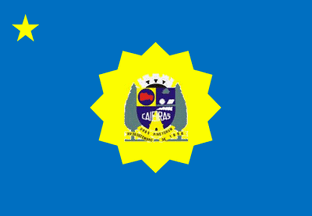 image by Dirk Schönberger,
8 October 2012
image by Dirk Schönberger,
8 October 2012Source: http://pt.wikipedia.org/wiki/Caieiras

Last modified: 2012-11-04 by ian macdonald
Keywords: sao paulo | caieiras |
Links: FOTW homepage |
search |
disclaimer and copyright |
write us |
mirrors
 image by Dirk Schönberger,
8 October 2012
image by Dirk Schönberger,
8 October 2012
Source:
http://pt.wikipedia.org/wiki/Caieiras
A blue field, with a small yellow star in the upper hoist, and a large 12-pointed yellow sun in the centre, bearing the municipal logo.
Official website at
http://www.caieiras.sp.gov.br. The
flag description can be found on the official site at
http://www.caieiras.sp.gov.br/portal/index.php/simbolos.html.
Dirk Schönberger,
8 October 2012
Caieiras originated in the purchase by Colonel Antônio Proost Rodovalho of an estate located near river Juqueri-Guaçu. In 1877, the owner built two kilns to produce lime, which was transported by mules to the Perus railway station. The first settlers of the place were 180 workers of Italian origin, who constituted the first worker's estate in Brazil. The São Paulo Railway Company inaugurated on 19 June 1883 the Caieiras (from "cai", lime) railway station for which the neighbouring settlement was named, following the use of the time. The manufacturing of paper was initiated in Caieiras in 1890, when Rodovalho and his wife, Etelvina Dutra Rodrigues Rodovalho, acquired the Cia. Melhoramentos de São Paulo - today, Melhoramentos – MD Papéis, of national fame. The inauguration of the factory by the President of the São Paulo Province and other local politicians made the headlines of the "Jornal O Estado de São Paulo" on 20 April. Rodovalho planted a lot of eucalyptus and araucarias, which yielded the nickname of "Araucaria Town" to Caieiras. The municipality of Caieiras was established on 14 December 1958.
The symbols of Caieiras were designed by Nelson Antonio de Gasperi (1933-2010) who lived in the town from 1938 to 1965 and served as the Secretary of the municipal government for 14 years. He designed the coat of arms in 1962. In 1974, he designed the flag, winning a public contest organized by Father José.
The flag is blue with a canary yellow star in each corner. In the
middle of the flag is placed a canary yellow sun with 16 small
triangular rays, charged with the municipal coat of arms.
Blue represents the sky upon the town; the colour is used for the same
reason in all the quarters of the coat of arms (but see below).
The four stars are a tribute to the Piratininga Land - São Paulo,
which celebrated its fourth centenary in 1954, during the decade that
saw the emergence of Caieiras.
http://www.caieiras.sp.gov.br/portal/index.php/sme-conteudo-estatico/844-curiosidades-da-bandeira.html - Municipal website, with photos of the flag presented by the
designer and members of his family.
The coat of arms is prescribed by Law 326 of 9 August 1965, rephrasing Law no. 158 of 13 July 1962. The coat of arms is made of a blue shield with a yellow canton charged with a blue disk surrounding the red map of the town and surrounded by four white stars [yellow on the image]. The upper right quarter shows an araucaria surrounded by a gear wheel and an open book. The lower part of the shield shows a yellow lime kiln with white smoke, superimposed with the name of the town in white capital letters. The shield is surmounted by a mural crown argent. The shield is surrounded by two Japanese cedars. Below the shield a yellow scroll inscribed with the motto "URBS PINETORUM" (The Town of the Pines, here Araucarias) surrounded by the date "XIV DE DEZEMBRO" "DE 1958".
The Portuguese shield recalls the Lusitanian tradition.
Blue represents knowledge, loyalty, beauty and greatness in the acts,
characteristic of the inhabitants.
Canary yellow is related to the sun and its bright rays full of energy.
Red represents vigour and highness
The four stars are a tribute to the Piratininga Land - São Paulo,
which celebrated its fourth centenary in 1954, during the decade that
saw the emergence of Caieiras.
The gear wheel, the araucaria and the book represents paper industry
that allowed the emancipation of the municipality. The geometric
element on which stand these three charges represent the fecundity of
the soil and the aspiration of the inhabitants.
The lime kiln recalls the first historical movements that initiated the
settlement and eventually culminated in the today's town. The white smoke
symbolizes endless work, from which emerges the purity and victory of the
people's ideals. The Japanese cedars (Cryptomeria japonica (L. f.) D.Don), abundant
in the town, recalls that Caieiras is one of the most planted
municipality in the State.
The yellow scroll represents the richness of the local ideals. The
motto was coined by Olindo Dártora, one of the leaders of the struggle
for the emancipation of the town, which was obtained on 14 December
1958.
http://www.caieiras.sp.gov.br/portal/index.php/simbolos.html -
Municipal website
Ivan Sache, 4 November 2012